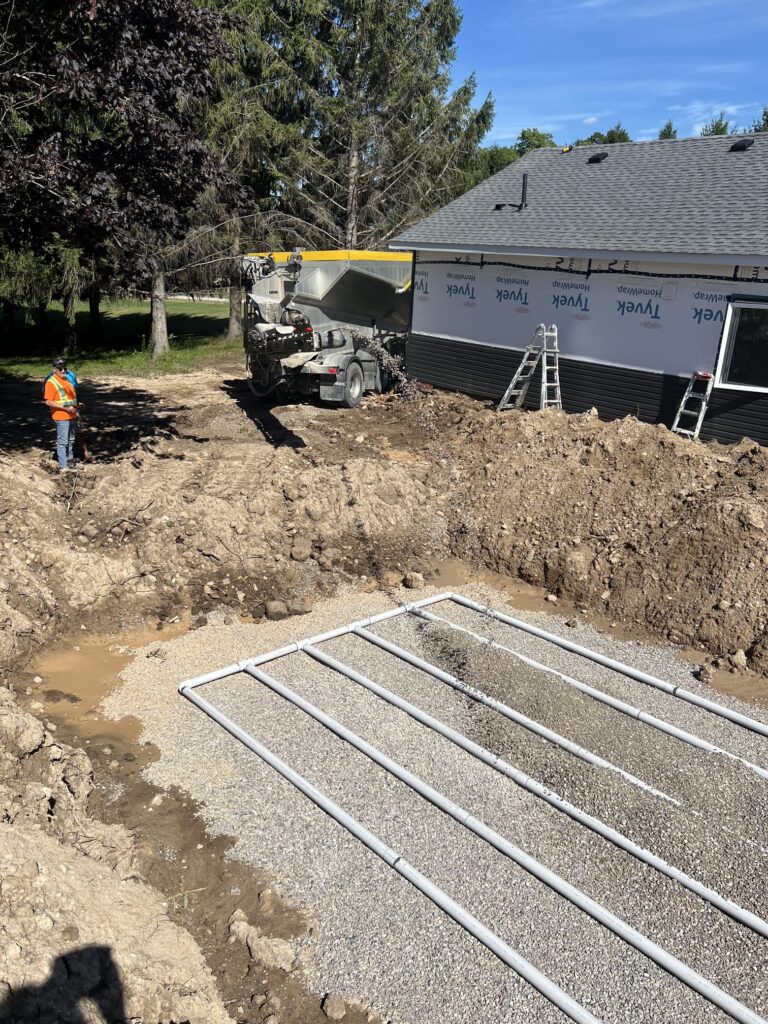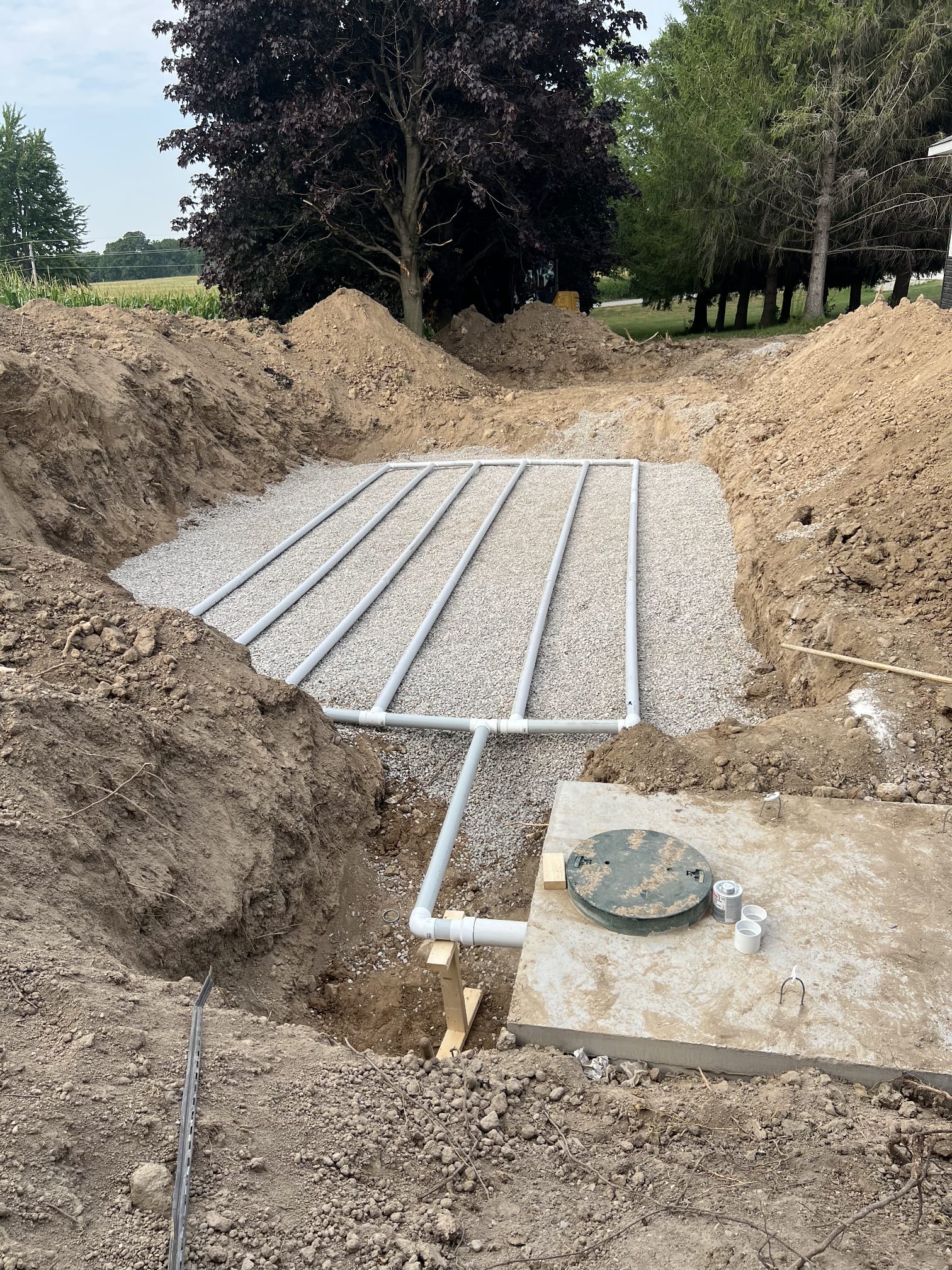Septic design Mount Forest focuses on creating safe and efficient on‑site wastewater systems tailored to the unique environmental conditions and regulatory requirements of Mount Forest, Ontario. This specialized approach ensures that homes and properties in Mount Forest have septic systems that protect health, safeguard groundwater, and comply with the Ontario Building Code.
Local Context for Septic Design in Mount Forest
Mount Forest is an unincorporated community in Wellington County, Ontario with a population of approximately 5 040 as of the 2021 census. Its humid continental climate brings cool summers and long, snowy winters, and its elevated terrain contributes to high snow loads and potential soil challenges. These environmental factors influence septic design Mount Forest because cold temperatures, snow cover, and soil permeability affect system performance and maintenance.
Regulatory Framework Governing Septic Systems
In Ontario, septic systems—also known as on‑site sewage facilities—must comply with Part 8 of the Ontario Building Code. These standards regulate system design, sizing, siting, construction, and maintenance. Designers must ensure septic systems in Mount Forest meet provincial code, with emphasis on soil suitability and compliance with local permits. Local municipalities may also enforce additional environmental assessments or separation requirements. Those designing systems in Mount Forest must be aware of both provincial codes and any municipal guidelines.
Soil Assessment and Percolation Testing
Effective septic design Mount Forest begins with careful soil evaluation. A percolation test, commonly called a “perc test,” measures the rate at which soil absorbs water and determines suitability for a leach field. Designers may also assess soil texture, structure, and depth to bedrock or high water tables to evaluate absorption and filtration capability. When soil covers bedrock or has low permeability, alternative systems like mound systems may be needed. In Mount Forest, soil conditions can vary due to glacial till and bedrock layers, making soil profiling essential to septic design.
System Types for Mount Forest Conditions
Traditional septic systems consist of a septic tank and subsurface leach field. Effluent from the tank is filtered through aerobic soil in trenches where microorganisms break down contaminants. When soil is permeable but not suitable for standard systems, mound systems offer an engineered alternative. They consist of a septic tank, dosing chamber, and raised sand mound to ensure effluent receives proper treatment before entering the soil. Designers in Mount Forest must choose the right system based on soil assessment and seasonal groundwater fluctuations.
Design Considerations Specific to Mount Forest
Designing septic systems in Mount Forest requires attention to frost depth, snow load, and elevation. Septic tanks and leach fields must be buried deep enough to remain below frost penetration, minimizing freezing risk in winter. Designers often increase insulation or select deeper burial depths in cold climates. Snow accumulation may delay visual inspection or maintenance access, so installations and venting must allow for efficient operation year‑round. The region’s elevation and potential for high groundwater during snowmelt also inform setback distances and drain field placement.
Licensed Designers, Permits, and Approvals
Ontario requires septic system designers to be licensed or certified and systems must be approved by local authorities before installation. In Mount Forest, homeowners must work with qualified professionals familiar with local environmental regulations and Building Code requirements. Approval processes often involve submitting soil test results, system design drawings, and site plans. Authorities evaluate compliance, required setbacks from wells or water bodies, and system suitability. Licensed designers help ensure septic design Mount Forest achieves regulatory approval and long‑term reliability.
Maintenance and Inspection Requirements
Once installed, septic systems must be properly maintained. Homeowners should routinely inspect and pump the septic tank to prevent solids from clogging the leach field. Environmental agencies often provide resources like Septic Smart guides that outline maintenance best practices, separation distances, and inspection intervals. Annual or periodic inspections can detect problems early, preserving system integrity and protecting groundwater. In Mount Forest, seasonal changes warrant checks before winter freeze and after snowmelt periods.
Expertise, Authority, and Trust in Design
Effective septic design Mount Forest demonstrates expertise when conducted by certified professionals familiar with Ontario regulations, climate dynamics, and soil variability. Authority comes from adherence to the Ontario Building Code and by working with engineers or certified designers who understand local conditions. Trust is built through transparent communication, quality installation, and ongoing maintenance plans. Homeowners benefit when their septic system design reflects responsible planning and environmental stewardship.

Site-Specific Engineering and Topographic Adjustments
Septic design Mount Forest must address not only soil and climate but also site topography. Sloped lots or uneven ground can interfere with gravity-fed systems and require engineered solutions such as pump chambers or pressure distribution systems. These configurations allow for consistent effluent dispersal, preventing overload or runoff. Mount Forest terrain sometimes presents challenges due to its mix of agricultural clearings, forested lots, and rockier rural parcels. Designers must incorporate slope mapping, drainage analysis, and surface water redirection to optimize the layout. These engineered adjustments ensure treatment performance remains stable throughout seasons.
Environmental Protection and Groundwater Safety
Groundwater safety is essential in septic design Mount Forest because many homes rely on private wells for drinking water. A poorly designed or maintained septic system risks contaminating local water supplies with pathogens and nutrients. The Ontario Building Code enforces mandatory setback distances from wells, streams, and property lines, ensuring adequate natural filtration. Designers apply environmental best practices by increasing separation in shallow soils, avoiding flood-prone zones, and promoting aerobic treatment zones. The design must also consider cumulative impact in clustered developments to prevent localized saturation. Every decision aims to safeguard human health and the ecosystem.
How Elmid Design Inc Enhances Septic Planning
Elmid Design Inc provides expert septic design Mount Forest services with a focus on precision, compliance, and environmental stewardship. The firm holds a Certificate of Authorization from Professional Engineers Ontario (PEO), which ensures that all septic planning adheres to professional standards. Their designs incorporate detailed site analyses, performance modeling, and full regulatory submission packages for Wellington County. With a proven track record in both residential and rural commercial projects, Elmid Design Inc delivers plans that meet code and exceed environmental expectations. This level of oversight and accountability adds value and peace of mind to homeowners investing in reliable septic infrastructure.
Seasonal Factors Affecting System Longevity
Mount Forest winters are cold and long, which places strain on septic systems through ground freezing, ice buildup, and limited biological activity in leach fields. Designers must account for insulation, effluent warm-up times, and snow loads on access components. In spring, snowmelt can saturate soils and raise the water table, risking system backflow or surface discharge. Summer brings increased usage from seasonal property occupants, while fall requires preparation for freezing temperatures. Septic design Mount Forest must consider these seasonal swings to preserve system longevity and reduce the chance of emergency repairs. Proper planning helps homeowners avoid costly failures.
Common Design Mistakes and How to Avoid Them
One common error in septic design Mount Forest is underestimating the required drain field size. When daily flow estimates are inaccurate or soil testing is incomplete, the system can become overloaded and fail prematurely. Another mistake is installing components too shallow, leaving them vulnerable to frost damage in winter. Some designers also neglect vegetation planning, allowing root intrusion or heavy shade that prevents evaporation. Avoiding these pitfalls requires qualified professionals who base every design choice on data, experience, and code compliance. Thorough site evaluations and forward-thinking strategies minimize risk and extend system life.
Integrating Septic Design with Property Development Plans
Septic systems are often designed in isolation, but in Mount Forest, integrating septic design into the broader property development plan delivers better outcomes. Building placement, driveway routing, and future expansion zones all influence where the septic tank and leach field can go. Designers must collaborate with architects, engineers, and surveyors to ensure optimal use of land. Consideration of grading, lot drainage, and access for service vehicles must also be factored in. When septic design Mount Forest aligns with a property’s full potential, it supports not just function but also property value and long-term flexibility for the homeowner.
Importance of Documentation and As-Built Drawings
Once installation is complete, homeowners receive as-built drawings and maintenance instructions, which are essential for inspections, property sales, and future modifications. In Mount Forest, local authorities may require these documents for occupancy approval or land severance. A clear and accurate record of system layout, materials, and inspection dates ensures that future work can be completed efficiently without disrupting critical components. Elmid Design Inc provides comprehensive documentation for every project, making it easier for clients to maintain systems properly and comply with future regulations. This step reinforces transparency, trust, and responsible ownership.
Long-Term Cost Efficiency Through Quality Design
While upfront design and permitting costs may seem high, investing in quality septic design Mount Forest saves money over the system’s lifespan. Proper design reduces emergency repairs, premature component replacement, and regulatory fines. When systems are tailored to soil conditions, seasonal use patterns, and future capacity, they perform better for decades. Homeowners in Mount Forest benefit when professional designers optimize tank sizing, trench layout, and treatment type. Reduced pumping frequency, efficient effluent dispersal, and fewer disruptions make for lower total ownership cost. Informed choices in design pay off in reduced headaches and stable performance.
Replacing or Upgrading an Existing System
Many rural homes in Mount Forest rely on legacy septic systems installed decades ago under outdated codes. These older systems may be undersized, non-compliant, or near the end of their functional lifespan. Replacement or upgrade involves detailed assessment of existing conditions, including tank condition, field saturation, and plumbing infrastructure. Designers must create retrofit plans that meet modern standards while minimizing disturbance to existing landscaping or structures. In many cases, advanced treatment units or sand filters can allow system upgrades without expanding the field footprint. Elmid Design Inc supports both new installs and responsible replacements that improve performance and safety.
Detailed Cost Considerations in Septic Design
Septic design Mount Forest includes several cost components that vary by lot conditions, system type, and local fees. Design costs include soil testing, site surveys, and engineering plans, which may range based on property complexity. Installation costs rise when systems require advanced treatment units or large drain fields. Permitting fees from local authorities also apply and are necessary for approval. Maintenance costs such as regular tank pumping and inspections must be budgeted over time. Quality design reduces lifecycle costs by preventing early system failure and avoiding expensive repairs or legal penalties. Every dollar invested in design increases efficiency and long-term savings.
Choosing the Right Contractor for Mount Forest Projects
Contractor selection directly influences system reliability and project timelines. Homeowners should work with installers who have experience handling septic design Mount Forest specifically, as they will be familiar with soil types, elevation issues, and municipal regulations. It’s essential to choose licensed professionals who understand the Ontario Building Code and are comfortable collaborating with engineers. Elmid Design Inc works with trusted contractors in Wellington County to ensure that the design intent is accurately executed in the field. Working with reputable contractors ensures smooth inspections, clean installations, and successful permit closure without delays.
Innovations in Modern Septic System Design
Septic technology has evolved to include systems that protect water quality while reducing maintenance needs. Aerobic treatment units, filtration beds, and UV disinfection are now common in designs requiring extra treatment due to sensitive locations or tight space. In septic design Mount Forest, these technologies allow designers to work around difficult site conditions or proximity to water bodies. Innovative systems also help when small lots or existing structures limit options. Elmid Design Inc integrates advanced solutions when standard methods won’t suffice. These systems allow homeowners to develop land responsibly while meeting all health and environmental regulations.
Understanding the Permit and Inspection Process
The process for septic permits in Mount Forest starts with an application that includes site plans, soil test results, and full system drawings. Local authorities review submissions for compliance with Part 8 of the Ontario Building Code. Inspectors conduct field visits during key stages, such as excavation and before backfilling. Final inspections verify installation integrity and component access. Elmid Design Inc prepares clients for every phase of approval and ensures documents meet municipal and provincial requirements. Being prepared for each inspection stage speeds up occupancy permits and protects the homeowner from costly remediation orders or construction delays.
Educating Homeowners on System Operation
Even the best design can fail without proper use and maintenance. Septic design Mount Forest must include homeowner education so that new system owners understand how to care for their infrastructure. Designers and installers should explain what can and cannot enter the system, expected pumping schedules, and how to recognize early signs of failure. Clear instructions help protect groundwater, extend system life, and reduce emergencies. Elmid Design Inc includes operation guides and records with each project. When clients know how their system works, they become active participants in preserving its function and environmental safety.
Septic System Design and Future Land Use Planning
Mount Forest continues to grow, and homeowners often plan for future expansions like garages, accessory buildings, or subdivisions. Septic design Mount Forest must leave room for secondary fields, system upgrades, or site alterations. Proper planning during initial design ensures that the system won’t interfere with future construction or require costly relocation. Designers analyze how setbacks, terrain, and lot layout can accommodate long-term land use. Elmid Design Inc prepares flexible designs that support future changes without compromising code compliance. This foresight preserves development options and increases property value.
Addressing Common Septic System Failures
Septic systems can fail due to overloading, root invasion, improper use, or neglect. In Mount Forest, seasonal water saturation and freeze-thaw cycles can also cause leach field failure or tank floatation. Good septic design prevents these issues by accounting for site limitations and ensuring correct installation methods. When failures occur, professional assessment is required to determine if repair or full replacement is necessary. Elmid Design Inc offers troubleshooting support and retrofit plans that bring failing systems up to modern standards. Corrective action protects health and minimizes long-term costs when failure signs are addressed early.
Frequently Asked Questions About Septic Design Mount Forest
What permits are required for a septic system in Mount Forest?
You must apply for a building permit that includes septic system design under Part 8 of the Ontario Building Code, submitted to Wellington County.
How long does it take to design and install a septic system?
It typically takes several weeks to complete soil testing, design, and permit approval. Installation depends on weather, contractor availability, and site complexity.
Can I install a septic system without a licensed designer?
No. Ontario requires septic designs to be prepared by qualified professionals, often licensed by PEO or registered under the Building Code.
What if my soil is not suitable for a traditional system?
Alternative systems like mound systems or advanced treatment units can be used. Your designer will choose the most suitable system based on site conditions.
How often should a septic tank be pumped?
Most systems require pumping every three to five years, but usage and tank size can affect frequency. Regular inspections help determine timing.

Why Elmid Design Inc Leads in Septic Design Mount Forest
Elmid Design Inc is a licensed engineering firm with a Certificate of Authorization from Professional Engineers Ontario, offering expert septic design Mount Forest solutions. Known for technical precision, regulatory compliance, and client-focused service, the company ensures every system meets Ontario Building Code standards while protecting the environment. With deep local knowledge and proven design success, Elmid Design Inc supports homeowners through every stage from site evaluation to permit approval delivering safe, efficient, and future-ready septic systems across Mount Forest and Wellington County.
Geographic Locations That We Service:
Our Licensed Professional Engineers specializing in Engineered Site Grading Plans offer the best-engineered site grading plan, lot grading and erosion plan, and drainage plan to obtain site plan approval and building permits in Ontario, including a wide range of municipalities. Each area boasts unique features and requirements, making our tailored approach essential for success.
Toronto and Surrounding Areas
In the vibrant heart of Ontario, we service Toronto (City of Toronto) and surrounding areas. Additionally, we cover Oshawa (City of Oshawa), Pickering (City of Pickering), and Clarington (Municipality of Clarington). Furthermore, our expertise extends to Ajax (Town of Ajax), Whitby (Town of Whitby), Brock (Township of Brock), Scugog (Township of Scugog), and Uxbridge (Township of Uxbridge).
Halton Region
Moving to the Halton Region, our services encompass Burlington (City of Burlington) and Halton Hills (Town of Halton Hills). Also included are Milton (Town of Milton) and Oakville (Town of Oakville).
Peel Region
In the Peel Region, we provide services in Brampton (City of Brampton), Mississauga (City of Mississauga), and Caledon (Town of Caledon).
York Region
Our services in the York Region cover Vaughan (City of Vaughan), Aurora (Town of Aurora), and East Gwillimbury (Town of East Gwillimbury). We also cater to Georgina (Town of Georgina), Markham (City of Markham), Newmarket (Town of Newmarket), Richmond Hill (City of Richmond Hill), Whitchurch-Stouffville (Town of Whitchurch-Stouffville), King (Township of King), and Bradford-West Gwillimbury (Town of Bradford-West Gwillimbury). Each municipality here offers a distinct setting, requiring our specialized approach.
Other Southern Ontario Cities and Towns
We also serve many other cities and towns in Southern Ontario. These include Hamilton (City of Hamilton), St. Catharines (City of St. Catharines), Niagara on the Lake (Town of Niagara on the Lake), Brant (County of Brant), Cambridge (City of Cambridge), Kitchener (City of Kitchener), Waterloo (City of Waterloo), and Woodstock (City of Woodstock). Furthermore, we operate in Guelph (City of Guelph), Centre Wellington (Township of Centre Wellington), Shelburne (Town of Shelburne), Orangeville (Town of Orangeville), New Tecumseth (Town of New Tecumseth), Essa (Town of Essa), Collingwood (Town of Collingwood), Wasaga Beach (Town of Wasaga Beach), Barrie (City of Barrie), Midland (Town of Midland), Orillia (City of Orillia), Ramara (Town of Ramara), Minden Hills (Town of Minden Hills), North Kawartha (Town of North Kawartha), Kawartha Lakes (City of Kawartha Lakes), Peterborough (City of Peterborough), Selwyn (Town of Selwyn), and Brighton (Municipality of Brighton).




